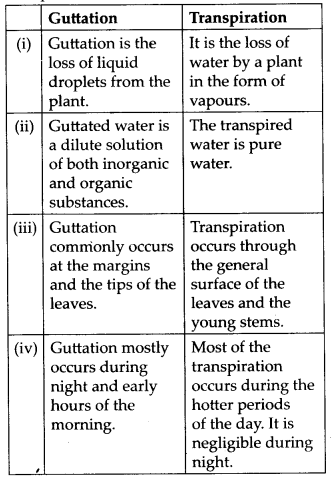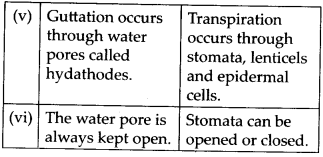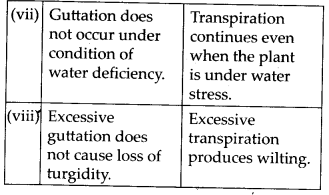Transport in plants : Notes and Study Materials -pdf
Transport in Plants Class 11 Notes Biology Chapter 11
Topics and Subtopics in for Class 11 Biology Chapter 11 Transport in Plants:
| Section Name | Topic Name |
| 11 | Transport in Plants |
| 11.1 | Means of Transport |
| 11.2 | Plant-Water Relations |
| 11.3 | Long Distance Transport of Water |
| 11.4 | Transpiration |
| 11.5 | Uptake and Transport of Mineral Nutrients |
| 11.6 | Phloem Transport: Flow from Source to Sink |
| 11.7 | Summary |
In flowering plants, a complex movement of materials take place in different directions. This is despite the fact that plants do not bear any circulatory system. Water taken up by the roots has to reach all the parts of the plant, up to very tip of the growing stem, where photosynthesis and growth are going on. Leaves manufacture food, which has to be supplied to all parts of the plant including the roots.
Materials also move over short distances, i.e., inside the cell, across the membranes or even cell to cell. The substances transported are water, mineral, nutrients, organic nutrients and plant growth regulators. Over short distances the substances move by diffusion and cytoplasmic streaming supplemented by active transport while, the long distance transport takes place through xylem and phloem and is called translocation.
Topic 1 Transport and Plant Water Relations
In rooted plants, water and mineral transport in xylem is unidirectional (roots to stems). However, translocation of organic and inorganic nutrients is multi directional. Organic compounds synthesised in the leaves are transported to all parts including storage organs.
The storage organs later re-export these organic compounds when required. Important nutrients are also withdrawn from plant parts undergoing senescence and are supplied to the growing parts. Hormones and plant growth regulators are present in very minute quantities and are often transported in polarised (unidirectional) manner.
Means of Transport
Transport in plant is an important phenomenon. It can either be unidirectional or bidirectional. There are mainly three important methods of transport of materials into and out of cells, i.e., diffusion, facilitated diffusion and active transport. These process are given below in details
1. Diffusion
It is a physical process in which passive transport of solvent molecules or solute ions occur without the expenditure of energy. It is a slow process and is independent of living system. During the process, the molecules or ions flow in a random fashion from the region of higher concentration to region of lower concentration be it a gas, liquid or solids. Rate of diffusion is mainly affected by
(а) Concentration gradient of diffusing substance.
(b) Permeability of the membrane separating them.
(c) Temperature
(d) Pressure
(e) Density
Note:
* Diffusion rate is inversely related to square root of relative density of the diffusing substance. This is known as Graham’s law of diffusion.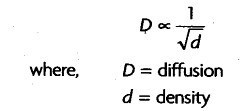
* Diffusion is a very important phenomenon in plants as it is the only means of transport of gases in them.
* Tendency of different substances to diffuse according to their own partial pressures or concentration is called independent diffusion.
2. Facilitated Diffusion
A favourable concentration gradient of molecules is essential for difiusion. The rate of difiusion depends on the size of the substances, i.e., smaller the substance, the faster it will diffuse and on its solubility in lipids (major constituents of membrane), i.e., more the substance is soluble in lipid, more faster it will diffuse through the membrane.
Transport of substances (having hydrophilic moeity) is facilitated by transport proteins. These protein do not create any concentration gradient by themselves; a concentration gradient is already present.
This process is called facilitated difiusion. Facilitated diffusion does not allow net movement of molecules from low to high concentration because it will require input of energy. The rate of transport finally reaches the maximum when all transporters of proteins are utilised.
Facilitated diffusion is very specific, i.e., allows uptake of only selected substances.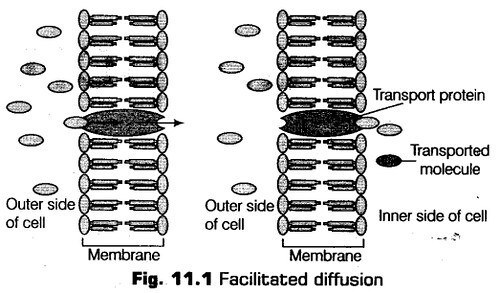
There are two different types of transport proteins, i.e., carrier proteins and channel proteins. Carrier proteins bind the particular solute to be transported and deliver the same to the other side of the membrane.
The channel proteins form channels in the cell membrane so s that molecules can easily get transported. This is called channel mediated facilitated difiusion. Out of these channels, some always remain open while, the others are controlled. The large transporter proteins, which create huge pores in the outer membranes of the plastids, mitochondria and bacteria to cross a variety of molecules up to the size of small proteins are called porins.
During transportation, the extracellular molecule binds to the transport protein which then rotates towards the intracellular matrix and releases the molecule inside the cell, e.g., Water channels made up of eight different types of aquaporins.
Note:
Aquaporin are membrane proteins for passive transport of water. They enhance the rate of transport of water across the membrane without altering the direction of transport.
Passive Symports and Antiports
In relation to facilitated diffusion, some carrier or transport proteins allow the movement of molecules only if two molecules move together. This type of movement is known as co-transport.
It can be of following three types
a. Symport
In this, both molecules cross the membrane in the same direction.
b. Antiport
In this both molecules cross membrane in opposite directions.
c. Uniport
In this type, the molecules moyes across a membrane independent of any other molecules
3. Active Transport
Active transport uses energy in the form of ATP to pump molecules or ions against a concentration gradient (i.e., uphill transport low concentration to high concentration). This is carried out by the carrier proteins in the plasma membrane. “When the transporters become saturated or are used up the rate of transport reaches its maximum level.
These carrier proteins are very specific in carrying protein across . the membrane. The ions once transported inside the membrane cannot return back to the outer space. While the carrier protein returns back to its original state in order to pick new ion or a molecule. These carrier proteins are very sensitive to inhibitors or other substances, which have the property of reacting with side chains of the proteins.
Comparison of Different Transport Processes
Out of the transport mechanisms discussed above, diffusion (whether facilitated or not) takes place along a concentration gradient without the utilisation of energy. However, both facilitated diffusion and active transport are mediated through membrane proteins.
Protein transporters are highly selective in nature, liable to get saturated, respond to inhibitors and are under hormonal regulation.
Comparison of Different Transport Process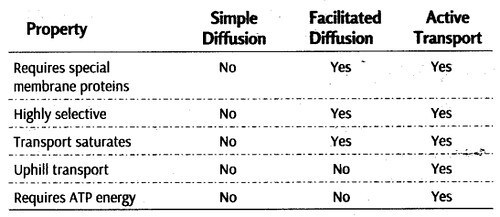
Plant Water Relations
Before discussing how absorption and transportation of water takes place in plants. It is necessary to understand some basic facts about water. Without the constant supply of water, the plant could not carry on any of its physiological activities.
Some useful functions of water are given below
(i) Water carries the nutrients from the soil to the plants.
(ii) Water acts as a major component of all living cells, i.e., a medium in which all substances are dissolved and undergo various types of reaction, e.g., protoplasm of cells is nothing but water containg several different molecules or suspended particles.
(iii) It acts as an excellent solvent and also acts as cooling system in plants.
(iv) Every plant whether herbaceous or woody consists of water but its amount varies, e.g., Herbaceous plant has 10-15% of its fresh weight as dry matter watermelon has 92% of water while woody plants has relatively very little water .
(v) It also acts as a major component of seeds (for their survival and respiration) although they appear dry.
(vi) It acts as a limiting factor for growth and productivity of plant in both agricultural and natural environments because of high demands of water by plants.
Note:
* A mature corn plant absorbs almost three litres of water in a day, while a mustard plant absorbs water equal to its own weight in about 5 hrs.
* Terrestrial plants take up huge amount water daily but most of it is loss to the air through transpiration (i.e., evaporation from the leaves).
* To understand plant water relation an understanding of action standard terms like water potential, solute potential, pressure potential etc
Water Potential
Potential is the way of representing free energy. All living organisms require free energy to grow, maintain metabolism and reproduce. As water molecules possess kinetic energy, they are in random motion (in both liquid and gaseous form) which is rapid and constant.
Thus, water potential is the difference between the free energy of water molecules in pure water and the energy of water in any other system. It is denoted by (psi) and expressed in pressure unit i.e., pascals (Pa). Greater the concentration of water in a system, greater will be its kinetic energy or water potential, i.e., pure water will have greatest water potential.
The best way to express spontaneous movement of water from one region to another is in terms of differences in the free energy of water between two region, i.e., one with the higher energy to one with the lower energy.
Thus, water will move from the system containing water with higher potential to the one having lower potential (down the gradient). Hence, this movement of water is called diffusion.
Note:
* The term water potential was first used by Slatyer and Taylor.
* By convention, the water potential of pure water at standard temperatures, which is not under any pressure, is taken to be zero.
* Water potential is always regarded as the tendency of water to leave a system.
Solute Potential
The magnitude by which water potential is reduced due , to the presence of a solute in pure water is known as solute potential. When solute or some substance is dissolved in pure water, the concentration of water decreases and solution will have fewer free water. It infers that the presence of solute particles in water reduces the free energy of water due to which water potential also decreases.
Solute potential is denoted by \J/S and is always negative (or has value less than zero). Hence,
More number of solute molecules = Lower solute potential (more — ve).
At atmospheric pressure for a solution
Pressure Potential
If a pressure more than atmospheric pressure is applied to pure water or a solution (containing solute), the water potential increases. This is equal to pumping water from one place to another such as our heart buildup pressure for the circulation of blood in the body.
When water enters a plant cell through diffusion, it becomes turgid due to building up of pressure against the cell wall in a plant system. This leads to increase in the pressure potential. It is usually positive known a turgor pressure and is denoted by fp. Loss of water during transpiration produces a negative hydrostatic pressure or tension in the xylem. This is very important in transport (Asent of sap) over long distances in plants.
Water potential is affected by both solute and pressure potential.
Osmosis
A plant cell is surrounded by both cell wall and cell membrane. The cell wall is freely permeable, i.e., it does not act like a barrier to the movement of water and other substances. The cell membrane and membrane of vacuole, the tonoplast are responsible for determination of water or other molecules in or out of the cell.
The large central vacuole and its contents (vacuolar sap) contributes to the solute potential of the cell.
Osmosis may be defined as the net movement of solvent molecules (water molecules) across a differentially or semipermeable membrane.
Osmosis takes place very spontaneously in response to a driving force.
The movement of solvent, in osmosis occurs due to the differences of water potential on two sides, i.e., water will move from a region of higher chemical potential to a region of lower chemical potential until the state of equilibrium is reached.
The net direction of molecules and rate of osmosis depends on two factors
(i) Pressure gradient
(ii) Concentration gradient.
Osmosis is a passive process and does not require any input of energy. Discovery of osmosis was made by Pfeffer.
Illustration of Osmosis
Phenomenon of osmosis can he easily understood on the basis of the diagram given below
On the basis of this following observations are made
(i) Solution in chamber B has a lower water potential (as it contains more number of solute particles
than A).
(ii) Solution in chamber A has a lower solute potential (as it has less number of solute particles, than B chamber) and B chamber has higher solute potential (as it contains high solute particles and less solvent, i.e., water).
(iii) Osmosis will takes place from chamber A —> B because as explained earlier osmosis always occurs from its region of higher chemical potential to a region of lower chemical potential.
One must not be confused with the movement of solvent (water) and movement of solute (water + solute particles) as solute always moves from a region of lower concentration to higher concentration and vice-versa in the case with solvent
(iv) At equilibrium, both chambers will have same water potential (i.e., neither A and B will have lower or higher water potential).
Note:
Endosmosis and Exosmosis The inflow of solvent (water) into a cell from outside when placed in distilled water, is called endosmosis in which cells swell up due to the entry of water and become turgid.
On the other hand, the outward flow of water from cell when placed in hypertonic solution like sugar solution, the cell tends to shrink and becomes flaccid. This outward flow of water in solution is called exosmosis.
The Funnel Experiment
This is another experiment, which is performed in the laboratory through which phenomenon of osmosis can be easily demonstrated.
Following steps are performed during this experiment
(a) A beaker is taken and filled with pure water.
(b) A thisde funnel is filled with sucrose solution and kept inverted in a beaker containing water (level is noted).
(c) The inverted funnel is separated from a pure water through a semi-permeable membrane.
(d) Level of the sucrose solution will rise into the funnel as water will move into the funnel as shown in fig (a).
(e) Water will continue moving till an equilibrium state is achieved.
If sucrose will diffuse out through the membrane, the equilibrium will not be reached ever, because for the state of equilibrium the concentration or gradient potential should be equal in both the chambers, i.e., funnel and beaker.
(f) External pressure is applied from the upper part of the funnel as in fig.(b) to stop the water movement into the funnel through the membrane.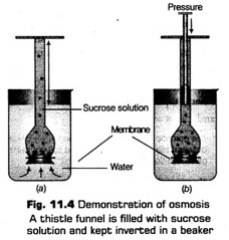
Differences between Diffusion and Osmosis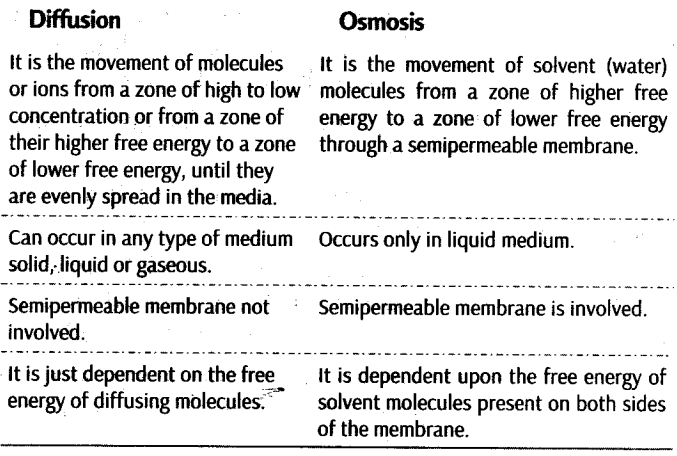
Significance of Osmosis
Osmosis is helpful in many ways as given below
(i) It helps in maintenance of cell turgidity.
(ii) Plays a vital role in stomatal movement during transpiration.
(iii) It helps in the movement of liquids across biological membranes.
(iv) It also have effects on absorption of water by roots.
Osmotic Pressure
It is that pressure of a solution, which must be applied to the solution in order to allow passage of solvent due to osmosis. This is also the function of solute concentration; i.e., more the concentration of a solute, greater will be the amount of pressure applied in order to prevent water from diffusing. Osmotic pressure is numerically equal to the osmotic or solute potential but osmotic potential has a negative sign, while osmotic pressure is always a positive pressure.
The osmotic pressure of a solution largely depends upon the ratio between the number of solute and solvent particles present in a given solution.
Note:
* Instrument used for measuring osmotic pressure is called osmometer, eg., Berkeley and Hartleys osmometer.
* Reverse osmosis is expulsion of pure water from solution through a semipermeable membrane under the influence of external pressure, higher than OP of solution.
Differences between Osmotic Pressure and Osmotic Potential
Types of Solutions
The plant cells or tissues behave according to the movement of water depending upon the surrounding solution. Thus, on the basis of concentration of cell sap (cellular solution found in large central vacoule of a living plant cells).
The solutions are of following three types (i) Isotonic Solution It is a type of solution, which has a similar concentration as the cell sap of the cells, i.e., No change occurs in a cell after placing it in isotonic solution.
(ii) Hypotonic Solution It is a type of solution which has lower concentration (more diluted) than the cell sap. The cell swells up when placed in this solution.
(iii) Hypertonic Solution It is a type of solution which has higher concentration than the cell sap of cells. The cells shrink, when placed in hypertonic solution.
Note:
The term ‘Diffusion Pressure Deficit’ (DPD) was coined by BS Meyer in 1938. The amount by which diffusion pressure of a solution is lower than that of its pure solvent is known as diffusion pressure deficit.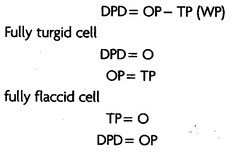
Plasmolysis
This phenomenon occurs when water moves out of the cells and the cell membrane of a plant cell shrinks away from its cell wall when placed in a hypertonic solution (having more concentration). During the process the hypertonic solution causes exosmosis (outward movement of water).
The water first moves out from the cytoplasm and then from the central vacoule. This withdrawal of water through diffusion into the extracellular fluid causes the cell to shrink in size, due to which cell moves away from the walls. The cells is said to be plasmolysed.
The space between the cell wall and the shrunken protoplast is occupied or filled by the eternal solution.
At limiting plasmolysis the pressure of external solution balances the osmotic pressure of the cytoplasm. Thus, during this state of equilibrium when flow of water into and out of the cell is same, the cells are called flaccid.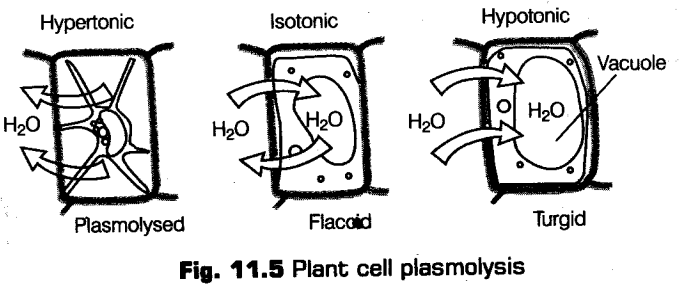
Deplasmolysis
The process in which the plasmolysed cell when placed in pure water or hypotonic solution, builds up a turgor pressure (in which water enters the cell and cause the cytoplasm to build up a pressure against the wall). It is mainly responsible for enlargement and extensive growth of the cells. During this stage, water enters due to endosmosis and cell again becomes turgid when protoplast attains its original shape and size. As cell wall is rigid, the cell do not rupture. The pressure exerted against rigid wall due to the entry of water by the protoplasts is called pressure potential, i.e., fp .
(i) Deplasmolysis should be followed immediately after plasmolysis otherwise the cell protoplast becomes damaged permanently.
(ii) Pressure potential of a flaccid cell is zero because there is no net movement of water in and out of the cell.
(iii) Cell wall is found in bacteria, fungi, algae some archea and plant cells (animals and protozoans do not have cell wall).
Differences between Plasmolysis and Deplasmolysis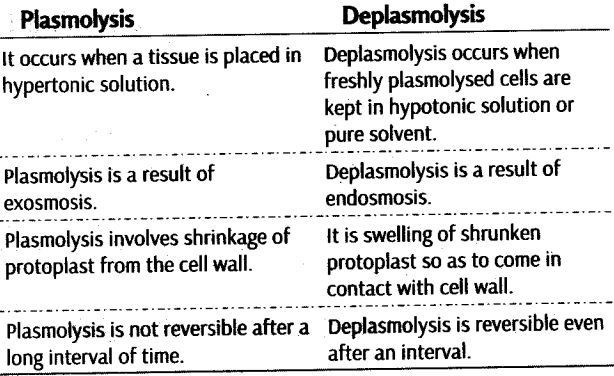
Significance of Plasmolysis
(i) It allows a plant cell to lose water without dying, it can shrink or increase in size as water is available within the constraints of the cell wall.
(ii) It is shown by living cells. By this we can determine whether a cell is living or dead.
(iii) It helps in determining osmotic pressure of plants.
(iv) It proves that cell wall is elastic and permeable.
Imbibition
It is a special phenomenon in which water or any other liquid is absorbed by the solid particles (colloids) of a substance. This leads them to increase enormously in volume. The solid particles which imbibe water or any other liquid are called imbibants. The liquid, which is imbibed is known as imbibate. It is also a type of diffusion because movement of water occur along concentration gradient as in diffusion. During imbibition, water molecules get tightly adsorbed and becc immobilised.
Note:
* During imbibition water molecule lose most of their kinetic energy in the form of heat. This is called heat of hydration or heat of wetting
* Imbibition can be best explained and seen in absorption of water by seeds and drywood which acts as absorbents to imbibe water and swell.
Imbibition Pressure
The pressure developed by solid particles, which adsorbs water or any other liquid when submerged in pure imbibing liquid is called imbibition pressure. It is due to this pressure in plants that seedlings emerge out of the soil and establish themselves.
Conditions necessary for imbibition to take place are
(i) Affinity between the adsorbant and the liquid imbibed is essential.
(ii) Water potential gradient between the absorbent and the liquid imbibed.
The phenomenon of imbibition is also influenced by several factors like temperature (increases with rise in temperature), pressure (decreases if pressure is against imbibant), pH (depends on change of imbibant) electrolytes (decreases) and texture of imbibant (increases if it is loose, decreases if it is compact in nature).
Importance of Imbibition
Imbibition plays following major roles
(i) Helps seedlings to come out of soil.
(ii) Acts at the initial stage in germination of the seeds.
(iii) Helps of seeds.
(iv) In older times, the imbibition pressure was used in breaking the rocks and stones.
(v) It is dominant in the initial stage of water absorption by roots.
Differences between Imbibition and Diffusion Imbibition Diffusion
Note:
Adsorption is property of colloids. Hence, material which have high proportion of colloids are good imbibants. eg., wood, is good imbibant as it contains proteins, cellulose and starch as colloidal substances.
Topic 2 Long Distance Transport of Water
Long distance transport of substances cannot take place by the process of diffusion alone. Diffusion accounts for only those molecules that move for
short distance and it is a very slow process. For instance, the movement of a molecule across a typical plant cell (about 50 pm) takes approximately 2.5 second. At this rate, the movement of molecules over a distance of 1 m would take approximately 32 years by diffusion alone.
In large and complex organisms, sites of production or absorption and sites of storage are far away from one another thus, the substances to be transferred have to follow a long path and move across very large distances.
Hence, some special long distance transport systems are necessary in order to transfer substances across long distances at much faster rate.
The movement of water, minerals and food across long distances is generally done by a mass or bulk flow system, which operates due to difference between the pressure of two points, i.e., the source and the sink. The substances whether dissolved or suspended in solution, are carried at a same speed. Such a movement is different from diffusion where different substances move independent of each other depending upon concentration gradients of their own. Mass or bulk flow movement occurs through vascular tissues, xylem and phloem of plants. The bulk movement of substances through conducting or vascular tissues of plant is called translocation.
There are generally two types of vascular tissues in plants which are responsible for translocation
(i) Xylem It is responsible for translocation of water with mineral salts, some organic nitrogen and hormones mainly from roots to aerial parts of plants.
(ii) Phloem It is responsible for translocation of organic and inorganic substances from leaves to other parts of the plant. Bulk flow can operate either due to positive hydrostatic pressure gradient (like a garden hose) as in phloem or a negative hydrostatic pressure gradient (like suction through a straw) as in xylem.
Absorption of Water by Plants
Plants absorb water through roots. However, the area of young roots where most absorption of water and minerals takes place is root hair zone. Root hairs are thin walled, slender extension of root epidermal cell present at the tip of the roots in millions. These are very delicate structure, which do not last for more than days or a week. They have very sticky walls that help in tight adhesion to the soil particles.
Tracheids and trachea of xylem transport water in plants.
Water once absorbed by file root hairs enter epidermis from where, it moves deeper into the root layers and finally reaches xylem following two pathways, i.e., apoplast and symplast.
Apoplast Pathway
Apoplast is the system of adjacent cell walls (i.e., interconnecting cell walls, intercellular spaces, cell wall of endodermis) that occur continuously throughout the plant, except at the casparian strips of endodermis in roots. In this pathway, the movement of water molecules takes place through intercellular spaces and the walls of the cells only. The water movement takes place along the gradient” from root hairs to xylem through the walls of intervening cells without crossing any membrane or cytoplasm.Thus, it does not provide any barrier to the movement of water, which occur through mass flow , due to adhesion and cohesion of water molecules.
There is no involvement of osmosis in the apoplast pathway.
Symplast Pathway
This system includes the living part of the plant cells made up of interconnected protoplasts of neighbouring cells and connected through cytoplasmic strands extending through plasmodesmata.
The water that enters into the cell sap of root hair as a result of active absorption, moves into the underlying cortex cells bounded by a continuous selectively permeable membrane through plasmodesmata.
The movement is relatively slower as water enters the cells through the cell membrane. The movement is again down the potential gradient. This pathway is aided by cytoplasmic streaming, which helps in quicker movement across individual cells. Thus, facilitating transport.
Cytoplasmic Streaming is an autonomous vital movement that occurs in eukaryotic cells continuously, e.g., around the central vacuole. Also known as cyclosis. It can be easily observed in the cells of Hydrilla leaf. The movement of chloroplast due to streaming is easily seen under microscope.
It is generally believed that both apopiast and symplast pathways are operative in plants but apopiast pathway offers less or no resistance. Thus, water continue to move through apopiast in the roots.
As the apopiast pathway is bfbcked by the bond of a suberised matrix called the casparian strip in the inner boundary of the cortex, the endodermix is imperious to water.
Therefore, the movement of water by and the endodermis occurs by the symplast pathway, i.e., water from the cell walls enter the cell cytoplasm and moves from one cell cytoplasm to another cell cytoplasm crossing the cell membrane through plasmodesmata and finally reaches the xylem elements.
Mycorrhizal Absorption
Instead of using root hairs for absorption many plants use mycorrhiza for water absorption. Mycorrhiza is a symbiotic association between a fungus and a young root system of a plant. Fungal hyphae have a very large surface area and extend into soil for sufficient distance, where a root cannot reach.
They absorb both mineral ions and water from the soil and provide these substances to the roots. The roots in turn provides sugar and N-containing compound to the mycorrhizae. The mycorrhizal association is obligate in many cases, e.g., seeds of Pinus and many orchid cannot ’ germinate properly without the development of mycorrhizal association.
Water Movement up a Plant (Ascent of sap)
Translocation of water or ascent of sap is usually upwards from the roots toward the top of the plant via stem, i.e., to the leaves and growing points or apical meristems and other aerial plant parts. It occurs through the tracheary elements of xylem. Many theories have been put forward to explain the upward movement of water.
Two of them are given below
Boot Pressure
It is believed that all plants absorb excess of water by an active process and tends to build up a positive hydrostatic pressure within the root system known as root pressure. Due to this activity the water is pushed upward along the length of the stem to a small height. The pressure inside the xylem is caused due to the diffusion pressure gradient and is maintained by the activity of living cells.
Demonstration of Root Pressure in Plants
At the start of the experiment, choose a plant having soft stem on a day when there is plenty of moisture in the atmosphere. Early in the morning cut the stem horizontally near the base, i.e., just above the soil with a sharp blade. The moment cut is made, few drops of solution start oozing out of the cut stem, which is due to the positive root pressure. Now in order to determine the rate of exudation (substances that oozes out) and the composition of the exudates (like sap, germs, latex, etc.), fix a vertical glass tuBe filled with water, with the help of a rubber tube to the cut end the stem. A column of sap is seen to ripe in the tube, which will be the measure of the root pressure.
Root pressure is inhibited or reduced during reduced aeration, low or high temperature, drought, etc.
Root pressure is maximum during early morning of spring and – rainy season when the level of evaporation is low or minimum and decreases with the advancement of day.
The magnitude of root pressure is about two bars or atmospheres.
Guttation
* When the amount of root pressure is high and rate of itranspiration is low, many herbaceous plants tend to loose small quantities of water or liquid in the form of drops from the hydathodes (small pores) or water glands. These are present on the margins of the leaves or where the main vein ends and near the tips of blades of some vascular plants like i i grasses and small herbaceous plants (rose, strawberry, tomato, etc).
* This phenomenon water loss in its liquid phase is called guttation. It takes place usually in early morning. The water that oozes out contains organic-and inorganic substances.
Contribution of Root Pressure
As root pressure contribute a modest push in the overall water transport. The enormous tension developed by transpiration, breaks the continuous chains of water molecules in the xylem which gets re-establish by the root pressure. In this way root pressure provides a great contribution in the transport of water.
Limitations to Root Pressure
Root pressure cannot account for the translocation of water or ascent of sap due to the following reasons
(i) It cannot lift sufficient amount of water upward to meet the requirement of water.
(ii) It fails to play a role in water movement in tall trees like gymnosperms, etc.
(iii) The amount of the fluid transported by the root pressure is not enough in measuring the movement of water in xylem in many trees.
(iv) Root pressure seems to be absent in summer when the requirements of water are high.
Although it plays a major role in the transport of water through xylem in some plants and some seasons but it does not account for majority of water transport due to which most plants fulfil their needs by transpiratory pull.
Transpiration Pull
Plants have a continuous water column in their xylem channels that starts at the base, i.e., roots and continues up to leaves from where water is lost through the process of transpiration. Thus, despite the absence of a circulatory system in plants, the flow of water upward through the xylem in plants achieve fairly high rates up to 15 meters per hour.
The water molecules in the water column remain attracted by the cohesive force and cannot be separated easily from one another. Thus, there is attraction between water molecules and the inner wall of xylem ducts. Hence, water column cannot be pulled away from the walls of xylem ducts due to strong adhesive and cohesive forces. This maintains the continuity of water column from roots to leaves.
Water is lost from mesophyll cells to the inter cellular spaces as a result of transpiration and develops a strong negative water potential. There are very large number of leaves and each leaf has thousands of transpiring mesophyll cells, which withdraw water from the xylem. This leads to a negative pressure in the water column, which exerts an upward pull over the water column. This pull is known as transpirational pull.
This tension or pull is transmitted up to the roots in search for more water. The water column (formed in the xylem elements of roots) now moves upward under the influence of transpirational pull.
Thus, the cohesive, adhesive forces and transpiration pull all help in lifting up of water through xylem elements and because of the critical role of cohesion the transpiration pull is also called cohesion-tension transpiration pull model of water transport.
Note:
Cohesion-tension theory was originally proposed by Dixon and Jolly in 1894 and further improved by Jolly in 1914.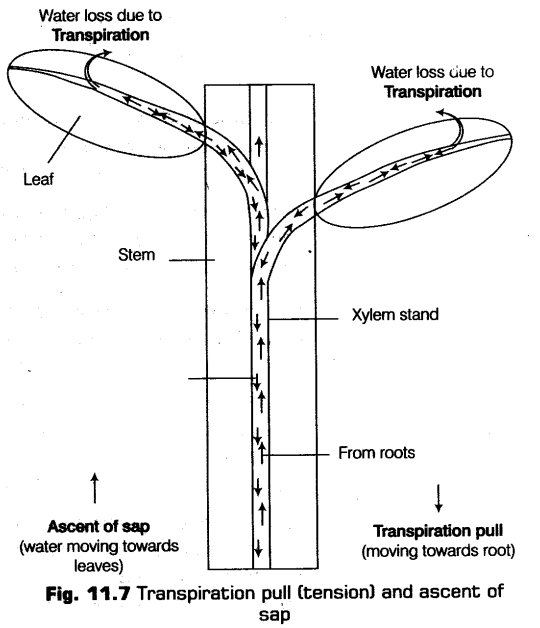
CBSE Class 11 Biology Chapter-11 Important Questions
1 Marks Questions
1.Name two anti-transpirants?
Ans. Phenyl mercuric acetate, Absissic acid.
2.Define translocation?
Ans. Transport of food through phloem vascular system is known as translocation.
3.When does wilting occur?
Ans. Wilting occurs when the loss of water by evaporation exceeds the rate of uptake by roots.
4.Name two factors that affect water potential?
Ans. Amount of solute & external pressures
5.Define plasmodesmata?
Ans. Plasmodesmata are protoplasmic connections between adjacent cells.
6.Why is salt added in excess to pickles?
Ans. High concentration of salts prevents the growth of microorganisms & thus it prevents spoilage of pickles.
7.What determines the direction of flow of water from one cell to another cell?
Ans. Water potential of cell (Ψ).
8.Define guttation.
Ans. Water loss in liquid phase from plants is called guttation
9.What is the water potential of pure water?
Ans. Zero bars.
10.Which part of the root is related with the absorption of water?
Ans. Root hairs.
11.What makes the raisins to swell up when kept in water?
Ans. Endosmosis.
12.Casparian strip is made of a substance which is impervious to water, Name this substance.
Ans. Suberin
13.What will happen to water potential when a solute is added to water ?
Ans. Water potential will decrease.
14.A plant cell when kept in a solution cot plasmolysed. What was the nature of the satiation.
Ans.Hypertonic.
15.Mention two ways of absorption of water by root hair in plants.
Ans. Apoplast and symplast pathway.
16.Which form of sugar is transported through phloem?
Ans. Sucrose.
17.Give one example of imbibitions.
Ans. Swelling of seed when put in water/moist soil.
18. A flowering plant is planted in an earthen pot and irrigated. Urea is added to make the plant row faster, but after some time ho plant dies. Give its possible reason.
Ans. Due to exosmosis ie water comes out the plant.
19.Why is energy required to develop root pressures?
Ans. Every activity requires energy. Root pressure develops due to activity of living cell.
2 Marks Questions
1.Why cell is called an osmotic system?
Ans. A cell is called as an osmotic system because:-
i)It has all the components of an efficient osmotic system i.e. a semi permeable Membrane & different concentration of sap on the two sides of membranes.
ii)Flow of water occurs from higher water potential to lower water potential.
2.Distinguish between active transport & passive transport.
Ans.
Active Transport | Passive Transport |
i) This is a rapid process. | i) this is a slow process |
ii) Energy is needed | ii) No need of energy |
iii) It is a vital process. | iii) It is a physical process. |
iv) Movement is one direction only | iv) Movement is in both directions |
v) Requires carrier proteins | v) does not require carrier proteins |
vi) Movement of metabolite against conc. gradient | vi) Movement of metabolite along the conc. gradient. |
3.Give the main purposes of transpiration?
Ans. i) Supplies water for the process of photosynthesis.
ii) Transports minerals from soil to all parts of a plant.
iii) Cools leaf surface by some 10-15 c by evaporative cooling
iv) Maintains shape of plant & structure by keeping cells turgid.
4.State the significance of plasmolysis?
Ans. Significance of plasmolysis :-
i) It explains osmosis
ii) Essential to know the biotic nature of the cell.
iii) Essential in killing of weeds.
iv)To determine the osmotic pressure of the cell.
v)As a proof of cell wall permeability.
5.Why is c4 photosynthetic system more beneficial than c3 photosynthetic system?
Ans. Evolution of c4 photosynthetic system is perhaps one of the strategies for maximizing availability of co2 while minimizing water loss. C4 plants are twice as efficient as C3 varieties in terms of carbon fixation eg. C4 plants will lose only 300g of water by evaporation for every gram of co2 fixed whereas C3 plants loses 600g of water for same grams of CO2 fixed.
6.Distinguish between transpiration & evaporation?
Ans.
Transpiration | Evaporation |
i) It is a physiological process where loss of water occurs through aerial parts of plants. | i) It is not physiological process but simply a physical process. |
ii) It takes place during the daytime | ii) It takes place at all the times |
iii) It is regulated by activity of guard cells around stomata | iii) It is not so. |
7.Mention two conditions necessary for imbibitions to occur?
Ans. i) Water potential gradient between the surface of absorbent & the liquid imbibed
ii) The affinity between the absorbent & the imbibed liquid.
8.What are the factors affecting the rate of diffusion.
Ans. The rate of diffusion is affected by the following:-
i) Gradient of concentration
ii) Permeability of cell membrane separating them.
iii) Temperature
iv) Pressure
9.What is the role of osmotic potential in regulating water potential of plant cells.
Ans. Osmotic potential refers to the pressure which is needed to stop the movement of water from outside into the solution. An isolated solution which is not bounded by any membrane has no osmotic pressure. It has only the potential to result into a pressure when placed in an osmometer
10. A well watered potted herbaceous plant shows wilting in the afternoon of a dry sunny day. Give reason.
Ans. During noon, the rate of transpiration becomes higher than the rate of water absorption by plant. If causes loss of turgidity and leads to wilting.
11.Do different species of plants slowing in the same soil show ho same the of transpiration of a particular time? Justify your answer.
Ans. Rate of transpiration is not same because transpiration is affected by num- bers and distribution of stomata, and their opening.
12. How is transpiration different from guttation 7 Give two points.
Ans.
Transpiration | Cuttation |
(i) Loss of water by a plant in form of vapours. (ii) Occurs through the general surface of leaves (stomata) and the young stems. | (i) The loss of liquid droplets from the plant. (ii) Occurs at the margins and the tips of the leaves. |
3 Marks Questions
1.Explain pressure flow hypothesis for translocation of sugars in plants?
Ans. most accepted mechanism for translocation of sugars source to sink is known as pressure flow hypothesis. The glucose is prepared at the source, it is converted into sucrose. The sugars is then moved in the form of sucrose into the companion cell, then into the living sieve tube cells by active transport loading at the source creates a hypertonic condition in vascular tissue- the phloem.
2. Explain why pure water has maximum water potential?
Ans. Pure water has maximum water potential because:-
i)Water molecules have kinetic energy, in liquid as well as the gaseous state they are in constant motion.
ii)The greater the concentration of water in a system, the greater its kinetic energy of its water potential.
iii)The pure water will have the greatest water potential.
iv)It two systems having water are in contact eg. soil & air or cell & solution, random movement of water molecules will occur from the system with higher energy to one with lower energy. At equilibrium, the water will move from the system containing water at higher water potential to one having low water potential.
v)Water potential is represented by Psi or Ψ . It is expressed in pressure units such as Pascal. Water potential of pure water at defined temperature & pressure is taken to be zero.
vi)If on pure water a solute is dissolved, its concentration decreases thereby reducing its water potentials so, all solutions have lower water potential than pure water.
3.Explain facilitated diffusion?
Ans. Facilitated diffusion is also called carrier mediated diffusion or transport by carrier proteins. It occurs along the concentration gradient assisted by carrier proteins eg. diffusion of glucose in RBC’s. The membrane provides sites at which some molecules cross the membrane. They do not set up a concentration gradient. A concentration gradient is present for molecules to diffuse even if facilitated by proteins membrane without expenditure of ATP energy. It cannot cause net transport of molecules from a low to high concentration as it requires input of energy. Transport rate reaches maximum when all of the protein transporters are being used. It is very specific & permits a cell to select with protein side chains. Facilitated diffusion is stereo specific the carrier proteins are permeases.
4.Describe water potential? What are the factors influencing it?
Ans. Water potential is represented by  The water mover from the point where water potential is greater to the other where it is less. It is denoted by psi or
The water mover from the point where water potential is greater to the other where it is less. It is denoted by psi or  .Water potential is the chemical energy of water. It is measured in terms of pressure & is also influenced by concentration gravity as well as pressure. The chemical potential of water is called water potential. It indicates free energy rotated to water. Water potential of pure water is zero.
.Water potential is the chemical energy of water. It is measured in terms of pressure & is also influenced by concentration gravity as well as pressure. The chemical potential of water is called water potential. It indicates free energy rotated to water. Water potential of pure water is zero.
Water moves into the cell from outside & hydrostatic pressure is increased. It increases water potential of a solute  but the difference between inside & outside is reduced. Water moves from outside into the cell due to water potential gradient.
but the difference between inside & outside is reduced. Water moves from outside into the cell due to water potential gradient.
Three factors affect water potential. They are matric potential , solute potential
, solute potential  & pressure potential
& pressure potential . Solute potential is always negative. Pressure potential is usually positive & is denoted by
. Solute potential is always negative. Pressure potential is usually positive & is denoted by . Thus, water potential is affected by both solute & pressure potential. The relationship between them is
. Thus, water potential is affected by both solute & pressure potential. The relationship between them is 
5.Distinguishes between imbibitions & diffusion?
Ans.
Imbibition | Diffusion |
i) it occurs in living & dead both | i) it occurs in solids, liquids & gases. |
ii) It refers “to the absorption of water by general surface” | ii) It refers “to the movement of molecules, ions of gases, solids, liquids from the region of higher concentration to lower concentration. |
iii) An absorbent is involved but no membrane in it. | iii) No need of semi- permeable membrane |
iv) It is a reversible process. | iv) It is not a reversible process. |
6.Describe the plant cell as an osmotic system?
Ans. The plasma membrane in plant cell with the vacuolar membrane & cytoplasmic film or alone is more or less semi permeable in mature. This membrane allows the water molecules to get through it freely whereas it allows certain molecules to enter & prevent others. The cytoplasm is surrounded by the cell wall. It possesses very much higher concentration than the solutions entering the plant cells via osmosis. So the plant cell functions as an osmotic system if it fulfills the following two conditions:-
i) It has a semi-permeable membrane.
ii)It possesses a liquid substance having much higher concentration therefore, plant cell acts as osmotic system.
7.How is opening & closing of stomata controlled?
Ans. The factors affecting stomata opening & closing are:-
a) Light:- Light intensity needed for stomatal opening is low the stomata open in light but close in dark. In CAM plants, stomata open in dark & closed during daytime.
b) Temperature:- If temperature is increased, then the stomata open but when there is decrease in temperature the stomata close.
c) Availability of water:- The stomata are closed due to water stress or moisture deficit.
d) Concentration of CO2 :- If there is an increase in CO2 concentration inside the leaf the stomatal openings are closed even in light. When CO2 is used up by plant in photosynthesis the stomata open.
8. Differentiate between temporary and permanent writing. Do any of thorn indicate the water status of the soil ?
Ans.
Temporary wilting | Permanent willing |
(i) Plant recovers from temporary wilting Mt sometime. (ii) Much damage is not caused. (iii) It commonly occurs during mid-day only | (i) Automatic recovery is no possible. It may re if water is provided soon. (ii) Much damage is caused. (iii) It occurs throughout day and night |
9. Observe the given figure and give the answers of the following
(a) Identify the process occuring in (I), ( and (ill)
(h) Differentiate between the process II and III.
(c) How many types of aquaporins form the water channels in the cell membrane.
Ans.

10. Give the scientific term for the following statements/processes:
(a) Movement of water in roots exclusively. Through the cell wall
(b) The positive hydrostatic pressure developed inside the cell or cell wall.
(c) A solution having relatively less conecutnUon
(d) Loss of water from the aerial parts of the plants in the form of water vapours.
(e) Movement of a molecule across a membrane independent of other
(f) Water loss in its liquid phase through the special openings of veins near the tip of leaves of many herbaceous plants.
Ans. (a) Apoplast pathway
(b) Turgor pressure
(c) Hypotonie
(d) Transpiration
(e) Uniport
(f) Guttation
5 Marks Questions
1.Describe the cohesive force theory of ascent of sap in plants?
Ans. Cohesive force theory or transpirational pull theory was proposed by Dixon & jolly. Main aspects of this theory are:-
i) Strong cohesive force or tensile strength of water:- The water molecules attract each other by mutual force which is called the “cohesive force”. The attraction between the walls of xylem elements & the water molecules is called adhesion the cohesive force helps to maintain a long column of water under tension.
ii) Continuity of water column in plant:- air breaks do not hinders the total cohesive system & the tree are able to maintain a rapid flow of sap. The water or the sap can be pulled by the transpiration force.
iii)Transpiration pull or tension of unbroken column of water:- As a result of transpiration water is drawn in the intercellular spaces from the mesophyll cells which consequently draw water osmotically from nearby cells & thus a diffusion pressure deficit or suction force is developed. Due to suction force, the adjacent cells take water from xylem of these veins of the leaves. As the xylem of these veins is connected with xylem of roots through stem xylem a tension is set up in the water column of xylem & whole column is physically pulled up.
2.What forces are involved in absorption of water from soil by root hairs.
Ans. a)A negative tension is exerted down the roots due to transpiration on pull by the aerial parts of the plants this causes a decrease in water potential of roots which favours the uptake of water from the soil.
b) The decrease of water potential in the root cells than the soil favours the absorption of water from the soil.
c) The cohesive forces among the water molecules & adhesive forces between the water & xylem vessels maintain an unbroken column of water in capillaries of xylem vessels. The gradient of water potential exists in the xylem vessel starting from leaf to roots which favour uptake of water from the soil.
d) The water from the soil enters into the root hairs & from there it reaches the xylem vessel with lower water potential. It results in formation of root pressure. This root pressure pushes water to aerial parts of plant body.
3.Define transpiration? Why is it useful? Mention any three environmental factors that affect the transpiration?
Ans. Transpiration is a phenomenon naturally occurring in plants through which water is lost from plants in the form of water vapours through their aerial parts. It is useful to plants because
(i) It helps in movement of xylem sap.
(ii)It causes cooling of leaf surface & thereby protects leaf from heat injury by intense sunlight
Transpiration is affected by 3 environmental factors:-
a)humidity:- water is lost slowly in the atmosphere, if the humidity is high or increased.
b)temperature:- the rate of transpiration is doubled with rise in temperature by 10.c
c)wind speed:- high wind speed or a dry breeze greatly increases the transpiration
NCRT TEXTBOOK QUESTIONS SOLVED
1.What are the factors affecting the rate of diffusion?
Solution. Factors affecting the rate of diffusion are :
- Density – Rate of diffusion of a substance is inversely proportional to square root of its relative density (Graham’s Law).
- Permeability of medium – Rate of diffusion decreases with density of the medium.
- Temperature – A rise in temperature increases the rate of diffusion with Q10 = 1.2 -1.3. Because of it sugar crystals do not dissolve easily in ice cold water while they do so easily in warm water.
- Diffusion pressure gradient – Rate of diffusion is directly proportional to the difference of diffusion pressure at the two ends of a system and inversely proportional to the distance between the two.
2.What are porins? What role do they play in diffusion?
Solution: The porins are proteins that form huge pores in the outer membranes of the plastids, mitochondria and some bacteria allowing molecules up to the size of small proteins to pass through. Thus they play an important ‘ role in facilitated diffusion.
3.Describe the role played by protein pumps during active transport in plants.
Solution: Active transport uses energy to pump molecules against a concentration gradient. Active transport is carried out by membrane play a major role in both active as well as passive transport. Pumps are proteins that use energy to carry substances across the cell membrane. These pumps can transport substances from a low concentration to a high concentration (‘uphill’ transport). E.g.,H+ pump,K+ pump, Cl- pump, Na+-K pump.The pumps operate with the help of ATP.K+-H+ exchange pump occurs in guard cells. Na+-K+ exchange pump operates across many animal membranes. Transport rate reaches a maximum when all the protein transporters or pumps are being used or are saturated.Like enzymes these carrier proteins are very specific in what they carry across the membrane. These proteins are sensitive to inhibitors that react with protein side chains.
4. Explain why pure water has the maximum water potential.
Solution: Water molecules possess kinetic energy. In liquid and gaseous form they are in random motion that is both rapid and constant. The greater the concentration of water in a system, the greater is its kinetic energy or ‘water potential’. Hence, it is obvious that pure water will have the greatest water potential. Water potential is denoted by the Greek symbol Psi or ψ and is expressed in pressure units such as pascals (Pa). By convention, the water potential of pure water at standard temperatures, which is not under any pressure, is taken to be zero. If some solute is dissolved in pure water, the solution has less free water and the concentration of water’decreases, reducing its water potential. Hence, all solutions have a lower water potential than pure water.
5.Briefly describe water potential. What are the factors affecting it?
Soln. The term water potential was first used by Slatyer and Taylor (1960). The free energy per mole of any particular chemical species in a multicomponent system is defined as the chemical potential of that species. The chemical potential of water is referred to as the water potential (ψw). Since the ψ of pure water is zero (0), the presence of solute particles reduces the free energy of water, thus decreases the water potential (negative value). Therefore,ψ of solution is always less than zero or its highest value is zero.
For solutions water potential is determined by three internal factors, i.e.,ψw = ψm + ψs + ψp (where ψm is matric potential which is used for the surface such as soil particles or cell wall to which water molecules are absorbed, ψsis solute potential, also called osmotic potential, the amount by which water potential is reduced and ψp is pressure potential such as TP and WP). Since in plant system ψm is disregarded the equation may be simplified as :
ψw = ψs + ψp
6. What happens when a pressure greater than the atmospheric pressure is applied to pure water or a solution?
Solution: If a pressure greater than atmospheric pressure is applied to pure water or a solution, its water potential increases. It is equivalent to pumping water from one place to another. Pressure can build up in a plant system when water enters a plant cell due to diffusion causing a pressure built up against the cell wall, it makes the cell turgid.
7. (a) With fhe help of well-labelled diagrams, describe the process of plasmolysis in plants, giving appropriate examples.
(b) Explain what will happen to a plant cell if it is kept in a solution having higher water potential.
Soln.(a) Shrinkage of the protoplast of a cell from its cell wall under the influence of a hypertonic solution is called plasmolysis. Hypertonic solution causes exosmosis or withdrawal of water from cytoplasm and then the central vacuole of cell. The size of cytoplasm, as well as central vacuole and hence protoplast, becomes reduced. The first stage of plasmolysis is called limiting plasmolysis. At limiting plasmolysis, the pressure potential ( ψp ) is zero and the osmotic concentration of cejl interior is just equivalent to that of external solution (isotonic). The cell is called flaccid. When pressure potential becomes negative, the protoplast withdraws itself from the comers. This stage is known as incipient plasmolysis. At incipient plasmolysis, the cell wall exerts no pressure on the cell contents (i.e. ψp is zero). Hence at this stage ψw = ψs. The hypertonic solution now enters the cell in between the protoplast and the cell wall. Due to continued exosmosis, protoplast shrinks further and withdraws from the cell wall except one or a few points. It is known as evident plasmolysis.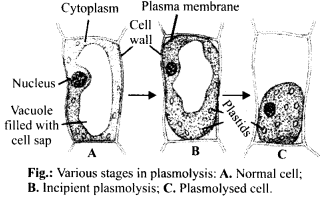
Examples of plasmolysis :
(i) Pickles, meat and fish are preserved by salting. Similarly, jams and jellies are preserved by sweetening with sugars. Salting and sweetening create hypertonic condition in which the fungi and bacteria get killed by plasmolysis.
(ii)Salting kills the weeds of lawns by inducing plasmolysis in their cells.
(iii)Plasmolytic method is applied for the determination of osmotic pressure of a cell in the laboratory.
(b) When the cells are placed in a solution having higher water potential i.e., hypotonic solution (dilute solution as compared to the cytoplasm), water diffuses into the cell causing the cytoplasm to build up a pressure against the wall, that is called turgor pressure. The pressure exerted by the protoplasts due to entry of water against the rigid walls is called pressure potential ψp . Because of the rigidity of the cell wall, the cell does not rupture. This turgor pressure is ultimately responsible for – enlargement and extension of cells.
8.How is the mycorrhizal association helpful in absorption of water and minerals in plants?
Soln. Some plants have additional structures associated with them that help in water (and mineral) absorption. A mycorrhiza is a symbiotic association of a,fungus with a root system. The fungal filaments form a network around the young root or they penetrate the root cells. The hyphae have a very large surface area that absorb mineral ions and water from the soil from a much larger volume of soil that perhaps a root cannot do. The fungus provides minerals and water to the roots, in turn the roots provide sugars and N-containing compounds to the mycorrhizae. Some plants have an obligate association with the mycorrhizae. For example Pinus seeds cannot germinate and establish without the presence of mycorrhizae.
9.What role does root pressure play in water movement in plants?
Soln. As various ions from the soil are actively transported into the vascular tissues of the roots, water follows (its potential gradient) and increases the pressure inside the xylem. This positive pressure is called root pressure, and can be responsible for pushing up water to small heights in the stem. Root pressure can, at. best, only provide a modest push in the overall process of water transport. They obviously do not play a major role in water movement up tall trees. The greatest contribution of root pressure may be to re-establish the continuous chains of water molecules in the xylem which often break under the enormous tensions created by transpiration.
10.Describe transpiration pull model of water transport in plants. What are the factors influencing transpiration? How is it useful to plants?
Soln.Transpiration pull or cohesion-tension theory was originally proposed by Dixon and Joly in 1894 and further improved by Dixon in 1914. According to this theory, a continuous
column of water is present in the xylem channels of plant. The continuity of water column is maintained in the plant because of cohesive force of water molecules. There is another force of adhesion which holds water tp the walls of xylem vessels. During transpiration in plants, water is lost, in form of water vapour, from the mesophyll cells to exterior, through stomata. As a result, the turgor pressure of these cells decreases and the diffusion pressure deficit (DPD) increases. Now these cells take water from adjoining cells and the turgor of those adjoining cells decreases. This process is repeated and ultimately water is absorbed from nearest xylem vessels of leaf. As there is a continuous water column inside the xylem elements, a tension or pull is transmitted down and finally transmitted to root, resulting in the upward movement of water.
Factors affecting transpiration include both environmental and internal factors. Environmental factors:
(i) Relative humidity – The rate of transpiration is inversely proportional to the relative humidity, i.e., the rate of transpiration is higher when the relative humidity is lower and lower when the relative humidity is higher.
(ii)Atmospheric temperature – A high temperature opens stomata even in darkness. Besides producing a heating effect, it lowers the relative humidity of the air and increases vapour pressure inside transpiring organ. Consequently, rate of transpiration increases.
(iii)Light – Because most of the transpiration occurs through stomata, the rate of transpiration is quite high is light. It falls down appreciably in the darkness.
(iv)Air movements – Transpiration is lower in the still air because water vapours accumulate around the transpiring organs and reduce the DPD of the air. The movement of the air increases the rate of transpiration by removing the saturated air around the leaves.
(v) Atmospheric pressure – Low atmospheric pressure enhances evaporation, produces air currents and increases the rate of transpiration.
(vi)Availability of water – The rate of transpiration depends upon the rate of absorption of soil water by roots. This is further influenced by a number of soil factors like soil water, soil particles, soil temperature, soil air, etc.
Internal or plant factors :
(i) Leaf area (transpiring area) – A plant with large leaf area will show more transpiration than another plant with less leaf area.
(ii)Leaf structure – Leaf structure affects transpiration in following ways:
(a) Cuticular transpiration decreases with the thickness of cuticle and cutinisation of epidermal walls.
(b) Because most of the transpiration takes place through the stomata, their number and position influences the rate of transpiration.
(c) The sunken stomata are device to reduce the rate of transpiration by providing an area where little air movement occurs.
(iii)Root/shoot ratio – A low root/shoot ratio decreases the rate of transpiration while a high ratio increases the rate of transpiration.
(iv)Mucilage and solutes – They decrease the rate of transpiration by holding water tenaciously.
Transpiration is useful to plants in the following ways:
(i) Removal of excess water – It has been held that plants absorb far more amount of water than is actually required by them. Transpiration, therefore, removes the excess of water.
(ii)Root system – Transpiration helps in better development of root system which is required for support and absorption of mineral salts.
(iii)Quality of fruits – The ash and sugar content of the fruit increases with the increase in transpiration.
(iv)Temperature maintenance – Transpiration prevents overheating of leaves. However, plants growing in areas where transpiration is meagre do not show over¬heating. Some succulents can endure a temperature of 60°C without any apparent damage.
(v)Pole in ascent of sap and turgidity – Ascent of sap mostly occurs due to transpiration pull exerted by transpiration of water. This pull is important in the absorption of water. Further, transpiration maintains the shape and structure of plant parts by keeping cells turgid.
(vi)Distribution of mineral salts- Mineral are mostly distributed by rising column of sap.
(vii)Photosynthesis – Transpiration supplies water for photosynthesis.
11.Discuss the factors responsible for ascent of xylem sap in plants.
Soln. Xylem sap ascends mainly due to forces generating in the foliage of plants as a result of active transpiration. Thus, the factors which enhance the rate of transpiration are also the factors responsible for ascent of xylem sap in plants.
Various factors responsible for ascent of xylem sap in plants are as follows:
(i) Capillarity: There is limited rise of water in narrow tubes or capillaries due to forces of cohesion amongst molecules of water and their property of adhesion to other substance.
(ii)Root pressure: It is positive pressure that pushes sap from below due to active absorption by root.
(iii)Transpiration pull: Transpiration in aerial parts brings the xylem sap under negative pressure or tension due to continuous withdrawal of water by them. Water column does not break due to its high tensile strength related to high force of cohesion and adhesion.
12.What essential role does the root endodermis play during mineral absorption in plants?
Soln. Like all cells, the endodermal cells have many transport proteins embedded in their plasma membrane; they let some solutes cross the membrane, but not others. Transport proteins of endodermal cells are control points, where a plant adjusts the quantity and types of solutes that reach the xylem. Because of the layer of suberin, the root endodermis has the ability to actively transport ions in one direction only.
13.Explain why xylem transport is unidirectional and phloem transport bidirectional.
Soln. Transport over longer distances proceeds through the vascular system (the xylem and the phloem) and is called translocation. In rooted plants, transport in xylem (to water and minerals) is essentially unidirectional, from roots to the stems. Organic and mineral nutrients however, undergo multidirectional transport. Food, primarily sucrose, is transported by the vascular tissue, phloem, from a source to a sink. Usually the source is part of the plant which synthesises the food,
i.e., the leaf, and sink, the part that needs or stores the food. But, the source and sink may be reversed depending on the season, or the plant’s needs. Since the source-sink relationship is variable, the direction of movement in the phloem can be upward or downward, i.e., bi-directional. Hence, unlike one-way flow of water in xylem, food in phloem tissues can be transported in any required direction.
14.Explain pressure flow hypothesis of translocation of sugars in plants.
Soln. The accepted mechanism used for the translocation of sugars from source to sink is called the pressure flow hypothesis. As glucose is prepared at the source i.e., in leaves, (by photosynthesis) it is converted to sucrose (a dissacharide). The sugar is then moved in the form of sucrose into adjacent companion cells and then into the living phloem i.e., in sieve tube cells by active transport. This process of loading at the source produces a hypertonic conditions in the phloem. Water in the adjacent xylem moves into the phloem by osmosis. As osmotic pressure builds up, the phloem sap will move to areas of lower pressure. At the sink, osmotic pressure must be reduced. Again active transport is necessary to move the sucrose out of the
phloem sap and into the cells which will use the sugar converting it into energy, starch, or cellulose. As sugars are removed, the osmotic pressure of the phloem decreases and water moves out of the phloem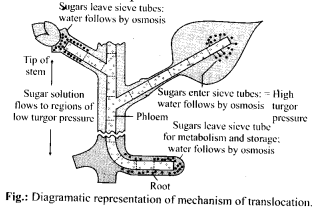
15.What causes the opening and closing of guard cells of stomata during transpiration?
Soln.Transpiration is the evaporative loss of water by plants. It occurs mainly through the stomata in the leaves. The immediate cause of the opening or closing of the stomata is change in the turgidity of the guard cells. The inner wall of each of the guard cells, towards the pore or stomatal aperture, is thick and elastic. When turgidity increases within the two guard cells flanking each stomatal aperture or pore, the thin outer walls bulge out and force the inner walls into a crescent shape and thus the stomata opens. The opening of the stoma is also aided due to the orientation of the microfibrils in the cell walls of the guard cells. Cellulose microfibrils are oriented radially rather than longitudinally making it easier for the stoma to open. When the guard cells lose turgor, due to water loss (or water stress) the elastic inner walls regain their original shape, the guard cells become flaccid and the stoma closes.
16.Differentiate between the following:
(a) Diffusion and Osmosis
(b) Transpiration and Evaporation
(c) Osmotic Pressure and Osmotic Potential
(d) Imbibition and Diffusion
(e) Apoplast and Symplast pathway of movement of water in plants
(f) Gutta’tion and Transpiration
Soln.
(a) Differences between diffusion and osmosis are as follows :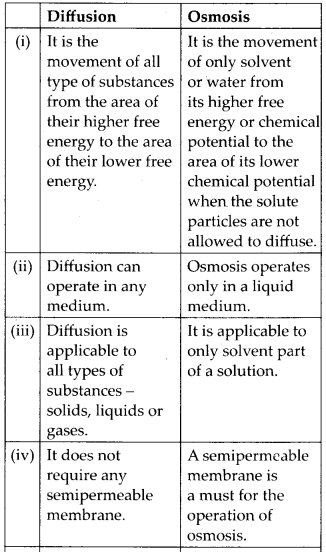

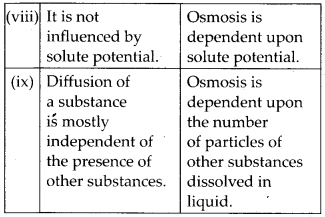
(b) Differences between transpiration and evaporation are as follows: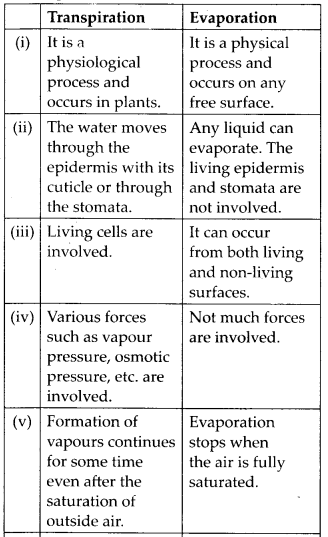
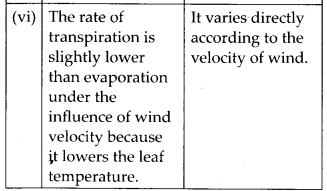
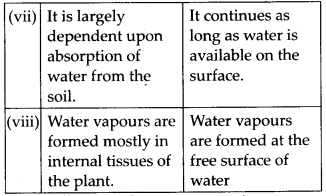
(c)Differences between osmotic pressure and osmotic potential are as follows: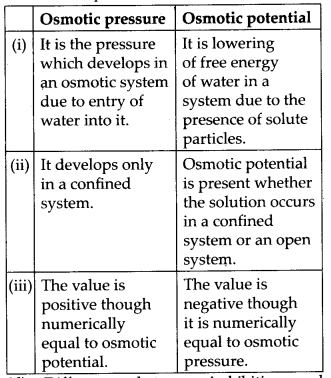
(d) Differences between imbibition and diffusion are as follows: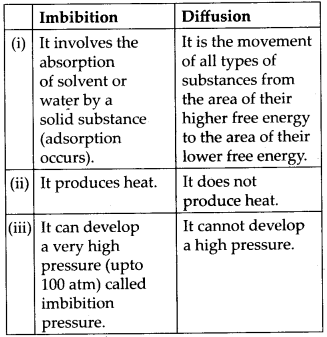
(e) Differences between apoplast pathway and symplast pathway are as follows: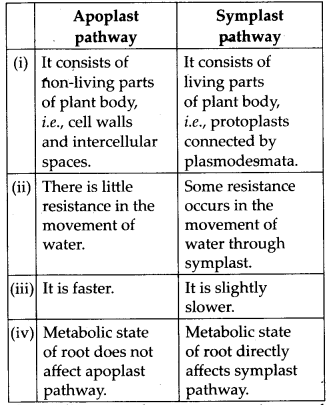
(f) Differences between guttation and transpiration are as follows: